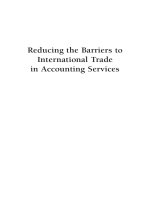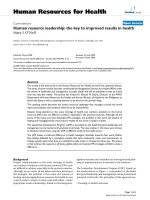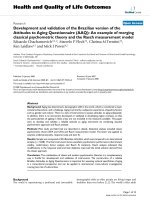The Microguide to Process Modeling in Bpmn 2.0 by MR Tom Debevoise and Rick Geneva_11 doc
Bạn đang xem bản rút gọn của tài liệu. Xem và tải ngay bản đầy đủ của tài liệu tại đây (1.97 MB, 27 trang )
In order to see more detail, we generate a full size version of the residuals versus predictor
variable plot. This plot suggests that the errors now satisfy the assumption of homogeneous
variances.
4.6.3.3. Transformations to Improve Fit
(5 of 5) [5/1/2006 10:22:49 AM]
4. Process Modeling
4.6. Case Studies in Process Modeling
4.6.3. Ultrasonic Reference Block Study
4.6.3.4.Weighting to Improve Fit
Weighting Another approach when the assumption of constant variance of the errors is violated is to perform
a weighted fit. In a weighted fit, we give less weight to the less precise measurements and more
weight to more precise measurements when estimating the unknown parameters in the model.
Finding An
Appropriate
Weight
Function
Techniques for determining an appropriate weight function were discussed in detail in Section
4.4.5.2.
In this case, we have replication in the data, so we can fit the power model
to the variances from each set of replicates in the data and use for the weights.
Fit for
Estimating
Weights
Dataplot generated the following output for the fit of ln(variances) against ln(means) for the
replicate groups. The output has been edited slightly for display.
LEAST SQUARES MULTILINEAR FIT
SAMPLE SIZE N = 22
NUMBER OF VARIABLES = 1
PARAMETER ESTIMATES (APPROX. ST. DEV.) T VALUE
1 A0 2.46872 (0.2186 )
11.
2 A1 XTEMP -1.02871 (0.1983 )
-5.2
RESIDUAL STANDARD DEVIATION = 0.6945897937
RESIDUAL DEGREES OF FREEDOM = 20
4.6.3.4. Weighting to Improve Fit
(1 of 6) [5/1/2006 10:22:53 AM]
The fit output and plot from the replicate variances against the replicate means shows that the
linear fit provides a reasonable fit, with an estimated slope of -1.03.
Based on this fit, we used an estimate of -1.0 for the exponent in the weighting function.
Residual
Plot for
Weight
Function
4.6.3.4. Weighting to Improve Fit
(2 of 6) [5/1/2006 10:22:53 AM]
The residual plot from the fit to determine an appropriate weighting function reveals no obvious
problems.
Numerical
Output
from
Weighted
Fit
Dataplot generated the following output for the weighted fit (edited slightly for display).
LEAST SQUARES NON-LINEAR FIT
SAMPLE SIZE N = 214
MODEL ULTRASON =EXP(-B1*METAL)/(B2+B3*METAL)
REPLICATION CASE
REPLICATION STANDARD DEVIATION = 0.3281762600D+01
REPLICATION DEGREES OF FREEDOM = 192
NUMBER OF DISTINCT SUBSETS = 22
FINAL PARAMETER ESTIMATES (APPROX. ST. DEV.) T
VALUE
1 B1 0.147046 (0.1512E-01)
9.7
2 B2 0.528104E-02 (0.4063E-03)
13.
3 B3 0.123853E-01 (0.7458E-03)
17.
RESIDUAL STANDARD DEVIATION = 4.1106567383
4.6.3.4. Weighting to Improve Fit
(3 of 6) [5/1/2006 10:22:53 AM]
RESIDUAL DEGREES OF FREEDOM = 211
REPLICATION STANDARD DEVIATION = 3.2817625999
REPLICATION DEGREES OF FREEDOM = 192
LACK OF FIT F RATIO = 7.3183 = THE 100.0000% POINT OF
THE
F DISTRIBUTION WITH 19 AND 192 DEGREES OF FREEDOM
Plot of
Predicted
Values
To assess the quality of the weighted fit, we first generate a plot of the predicted line with the
original data.
The plot of the predicted values with the data indicates a good fit. The model for the weighted fit
is
4.6.3.4. Weighting to Improve Fit
(4 of 6) [5/1/2006 10:22:53 AM]
6-Plot of
Fit
We need to verify that the weighted fit does not violate the regression assumptions. The 6-plot
indicates that the regression assumptions are satisfied.
Plot of
Residuals
4.6.3.4. Weighting to Improve Fit
(5 of 6) [5/1/2006 10:22:53 AM]
In order to check the assumption of equal error variances in more detail, we generate a full-sized
version of the residuals versus the predictor variable. This plot suggests that the residuals now
have approximately equal variability.
4.6.3.4. Weighting to Improve Fit
(6 of 6) [5/1/2006 10:22:53 AM]
4. Process Modeling
4.6. Case Studies in Process Modeling
4.6.3. Ultrasonic Reference Block Study
4.6.3.5.Compare the Fits
Three Fits
to
Compare
It is interesting to compare the results of the three fits:
Unweighted fit1.
Transformed fit2.
Weighted fit3.
Plot of Fits
with Data
The first step in comparing the fits is to plot all three sets of predicted values (in the original
units) on the same plot with the raw data.
This plot shows that all three fits generate comparable predicted values. We can also compare the
residual standard deviations (RESSD) from the fits. The RESSD for the transformed data is
calculated after translating the predicted values back to the original scale.
4.6.3.5. Compare the Fits
(1 of 2) [5/1/2006 10:22:54 AM]
RESSD From Unweighted Fit = 3.361673
RESSD From Transformed Fit = 3.306732
RESSD From Weighted Fit = 3.392797
In this case, the RESSD is quite close for all three fits (which is to be expected based on the plot).
Conclusion Given that transformed and weighted fits generate predicted values that are quite close to the
original fit, why would we want to make the extra effort to generate a transformed or weighted
fit? We do so to develop a model that satisfies the model assumptions for fitting a nonlinear
model. This gives us more confidence that conclusions and analyses based on the model are
justified and appropriate.
4.6.3.5. Compare the Fits
(2 of 2) [5/1/2006 10:22:54 AM]
4. Process Modeling
4.6. Case Studies in Process Modeling
4.6.3. Ultrasonic Reference Block Study
4.6.3.6.Work This Example Yourself
View
Dataplot
Macro for
this Case
Study
This page allows you to repeat the analysis outlined in the case study
description on the previous page using Dataplot, if you have
downloaded and installed it. Output from each analysis step below will
be displayed in one or more of the Dataplot windows. The four main
windows are the Output window, the Graphics window, the Command
History window and the Data Sheet window. Across the top of the main
windows there are menus for executing Dataplot commands. Across the
bottom is a command entry window where commands can be typed in.
Data Analysis Steps Results and Conclusions
Click on the links below to start Dataplot and run this case study
yourself. Each step may use results from previous steps, so please be
patient. Wait until the software verifies that the current step is
complete before clicking on the next step.
The links in this column will connect you with more detailed
information about each analysis step from the case study
description.
1. Get set up and started.
1. Read in the data.
1. You have read 2 columns of numbers
into Dataplot, variables the
ultrasonic response and metal
distance
2. Plot data, pre-fit for starting values, and
fit nonlinear model.
1. Plot the ultrasonic response versus
metal distance.
2. Run PREFIT to generate good
starting values.
3. Nonlinear fit of the ultrasonic response
1. Initial plot indicates that a
nonlinear model is required.
Theory dictates an exponential
over linear for the initial model.
2. Pre-fit indicated starting
values of 0.1 for all 3
parameters.
3. The nonlinear fit was carried out.
4.6.3.6. Work This Example Yourself
(1 of 3) [5/1/2006 10:22:54 AM]
versus metal distance. Plot predicted
values and overlay the data.
4. Generate a 6-plot for model
validation.
5. Plot the residuals against
the predictor variable.
Initial fit looks pretty good.
4. The 6-plot shows that the model
assumptions are satisfied except for
the non-homogeneous variances.
5. The detailed residual plot shows
the non-homogeneous variances
more clearly.
3. Improve the fit with transformations.
1. Plot several common transformations
of the dependent variable (ultrasonic
response).
2. Plot several common transformations
of the predictor variable (metal).
3. Nonlinear fit of transformed data.
Plot predicted values with the
data.
4. Generate a 6-plot for model
validation.
5. Plot the residuals against
the predictor variable.
1. The plots indicate that a square
root transformation on the dependent
variable (ultrasonic response) is a
good candidate model.
2. The plots indicate that no
transformation on the predictor
variable (metal distance) is
a good candidate model.
3. Carry out the fit on the transformed
data. The plot of the predicted
values overlaid with the data
indicates a good fit.
4. The 6-plot suggests that the model
assumptions, specifically homogeneous
variances for the errors, are
satisfied.
5. The detailed residual plot shows
more clearly that the homogeneous
variances assumption is now
satisfied.
4. Improve the fit using weighting.
1. Fit function to determine appropriate
weight function. Determine value for
the exponent in the power model.
2. Plot residuals from fit to determine
appropriate weight function.
1. The fit to determine an appropriate
weight function indicates that a
value for the exponent in the range
-1.0 to -1.1 should be reasonable.
2. The residuals from this fit
indicate no major problems.
4.6.3.6. Work This Example Yourself
(2 of 3) [5/1/2006 10:22:54 AM]
3. Weighted linear fit of field versus
lab. Plot predicted values with
the data.
4. Generate a 6-plot for model
validation.
5. Plot the residuals against
the predictor variable.
3. The weighted fit was carried out.
The plot of the predicted values
overlaid with the data suggests
that the variances arehomogeneous.
4. The 6-plot shows that the model
assumptions are satisfied.
5. The detailed residual plot suggests
the homogeneous variances for the
errors more clearly.
5. Compare the fits.
1. Plot predicted values from each
of the three models with the
data.
1. The transformed and weighted fits
generate only slightly different
predicted values, but the model
assumptions are not violated.
4.6.3.6. Work This Example Yourself
(3 of 3) [5/1/2006 10:22:54 AM]
4. Process Modeling
4.6. Case Studies in Process Modeling
4.6.4.Thermal Expansion of Copper Case
Study
Rational
Function
Models
This case study illustrates the use of a class of nonlinear models called
rational function models. The data set used is the thermal expansion of
copper related to temperature.
This data set was provided by the NIST scientist Thomas Hahn.
Contents
Background and Data1.
Rational Function Models2.
Initial Plot of Data3.
Fit Quadratic/Quadratic Model4.
Fit Cubic/Cubic Model5.
Work This Example Yourself6.
4.6.4. Thermal Expansion of Copper Case Study
[5/1/2006 10:22:55 AM]
4. Process Modeling
4.6. Case Studies in Process Modeling
4.6.4. Thermal Expansion of Copper Case Study
4.6.4.1.Background and Data
Description
of the Data
The response variable for this data set is the coefficient of thermal
expansion for copper. The predictor variable is temperature in degrees
kelvin. There were 236 data points collected.
These data were provided by the NIST scientist Thomas Hahn.
Resulting
Data
Coefficient
of Thermal Temperature
Expansion (Degrees
of Copper Kelvin)
0.591 24.41
1.547 34.82
2.902 44.09
2.894 45.07
4.703 54.98
6.307 65.51
7.030 70.53
7.898 75.70
9.470 89.57
9.484 91.14
10.072 96.40
10.163 97.19
11.615 114.26
12.005 120.25
12.478 127.08
12.982 133.55
12.970 133.61
13.926 158.67
14.452 172.74
14.404 171.31
15.190 202.14
15.550 220.55
4.6.4.1. Background and Data
(1 of 6) [5/1/2006 10:22:55 AM]
15.528 221.05
15.499 221.39
16.131 250.99
16.438 268.99
16.387 271.80
16.549 271.97
16.872 321.31
16.830 321.69
16.926 330.14
16.907 333.03
16.966 333.47
17.060 340.77
17.122 345.65
17.311 373.11
17.355 373.79
17.668 411.82
17.767 419.51
17.803 421.59
17.765 422.02
17.768 422.47
17.736 422.61
17.858 441.75
17.877 447.41
17.912 448.70
18.046 472.89
18.085 476.69
18.291 522.47
18.357 522.62
18.426 524.43
18.584 546.75
18.610 549.53
18.870 575.29
18.795 576.00
19.111 625.55
0.367 20.15
0.796 28.78
0.892 29.57
1.903 37.41
2.150 39.12
3.697 50.24
5.870 61.38
6.421 66.25
7.422 73.42
9.944 95.52
11.023 107.32
11.870 122.04
4.6.4.1. Background and Data
(2 of 6) [5/1/2006 10:22:55 AM]
12.786 134.03
14.067 163.19
13.974 163.48
14.462 175.70
14.464 179.86
15.381 211.27
15.483 217.78
15.590 219.14
16.075 262.52
16.347 268.01
16.181 268.62
16.915 336.25
17.003 337.23
16.978 339.33
17.756 427.38
17.808 428.58
17.868 432.68
18.481 528.99
18.486 531.08
19.090 628.34
16.062 253.24
16.337 273.13
16.345 273.66
16.388 282.10
17.159 346.62
17.116 347.19
17.164 348.78
17.123 351.18
17.979 450.10
17.974 450.35
18.007 451.92
17.993 455.56
18.523 552.22
18.669 553.56
18.617 555.74
19.371 652.59
19.330 656.20
0.080 14.13
0.248 20.41
1.089 31.30
1.418 33.84
2.278 39.70
3.624 48.83
4.574 54.50
5.556 60.41
7.267 72.77
4.6.4.1. Background and Data
(3 of 6) [5/1/2006 10:22:55 AM]
7.695 75.25
9.136 86.84
9.959 94.88
9.957 96.40
11.600 117.37
13.138 139.08
13.564 147.73
13.871 158.63
13.994 161.84
14.947 192.11
15.473 206.76
15.379 209.07
15.455 213.32
15.908 226.44
16.114 237.12
17.071 330.90
17.135 358.72
17.282 370.77
17.368 372.72
17.483 396.24
17.764 416.59
18.185 484.02
18.271 495.47
18.236 514.78
18.237 515.65
18.523 519.47
18.627 544.47
18.665 560.11
19.086 620.77
0.214 18.97
0.943 28.93
1.429 33.91
2.241 40.03
2.951 44.66
3.782 49.87
4.757 55.16
5.602 60.90
7.169 72.08
8.920 85.15
10.055 97.06
12.035 119.63
12.861 133.27
13.436 143.84
14.167 161.91
14.755 180.67
15.168 198.44
4.6.4.1. Background and Data
(4 of 6) [5/1/2006 10:22:55 AM]
15.651 226.86
15.746 229.65
16.216 258.27
16.445 273.77
16.965 339.15
17.121 350.13
17.206 362.75
17.250 371.03
17.339 393.32
17.793 448.53
18.123 473.78
18.49 511.12
18.566 524.70
18.645 548.75
18.706 551.64
18.924 574.02
19.100 623.86
0.375 21.46
0.471 24.33
1.504 33.43
2.204 39.22
2.813 44.18
4.765 55.02
9.835 94.33
10.040 96.44
11.946 118.82
12.596 128.48
13.303 141.94
13.922 156.92
14.440 171.65
14.951 190.00
15.627 223.26
15.639 223.88
15.814 231.50
16.315 265.05
16.334 269.44
16.430 271.78
16.423 273.46
17.024 334.61
17.009 339.79
17.165 349.52
17.134 358.18
17.349 377.98
17.576 394.77
17.848 429.66
18.090 468.22
4.6.4.1. Background and Data
(5 of 6) [5/1/2006 10:22:55 AM]
18.276 487.27
18.404 519.54
18.519 523.03
19.133 612.99
19.074 638.59
19.239 641.36
19.280 622.05
19.101 631.50
19.398 663.97
19.252 646.90
19.890 748.29
20.007 749.21
19.929 750.14
19.268 647.04
19.324 646.89
20.049 746.90
20.107 748.43
20.062 747.35
20.065 749.27
19.286 647.61
19.972 747.78
20.088 750.51
20.743 851.37
20.830 845.97
20.935 847.54
21.035 849.93
20.930 851.61
21.074 849.75
21.085 850.98
20.935 848.23
4.6.4.1. Background and Data
(6 of 6) [5/1/2006 10:22:55 AM]
4. Process Modeling
4.6. Case Studies in Process Modeling
4.6.4. Thermal Expansion of Copper Case Study
4.6.4.2.Rational Function Models
Before proceeding with the case study, some explanation of rational
function models is required.
Polynomial
Functions
A polynomial function is one that has the form
with n denoting a non-negative integer that defines the degree of the
polynomial. A polynomial with a degree of 0 is simply a constant, with a
degree of 1 is a line, with a degree of 2 is a quadratic, with a degree of 3 is a
cubic, and so on.
Rational
Functions
A rational function is simply the ratio of two polynomial functions.
with n denoting a non-negative integer that defines the degree of the
numerator and m is a non-negative integer that defines the degree of the
denominator. For fitting rational function models, the constant term in the
denominator is usually set to 1.
Rational functions are typically identified by the degrees of the numerator
and denominator. For example, a quadratic for the numerator and a cubic for
the denominator is identified as a quadratic/cubic rational function. The
graphs of some common rational functions are shown in an appendix.
4.6.4.2. Rational Function Models
(1 of 4) [5/1/2006 10:22:56 AM]
Polynomial
Models
Historically, polynomial models are among the most frequently used
empirical models for fitting functions. These models are popular for the
following reasons.
Polynomial models have a simple form.1.
Polynomial models have well known and understood properties.2.
Polynomial models have moderate flexibility of shapes.3.
Polynomial models are a closed family. Changes of location and scale
in the raw data result in a polynomial model being mapped to a
polynomial model. That is, polynomial models are not dependent on
the underlying metric.
4.
Polynomial models are computationally easy to use.5.
However, polynomial models also have the following limitations.
Polynomial models have poor interpolatory properties. High-degree
polynomials are notorious for oscillations between exact-fit values.
1.
Polynomial models have poor extrapolatory properties. Polynomials
may provide good fits within the range of data, but they will
frequently deteriorate rapidly outside the range of the data.
2.
Polynomial models have poor asymptotic properties. By their nature,
polynomials have a finite response for finite
values and have an
infinite response if and only if the
value is infinite. Thus
polynomials may not model asympototic phenomena very well.
3.
Polynomial models have a shape/degree tradeoff. In order to model
data with a complicated structure, the degree of the model must be
high, indicating and the associated number of parameters to be
estimated will also be high. This can result in highly unstable models.
4.
Rational
Function
Models
A rational function model is a generalization of the polynomial model.
Rational function models contain polynomial models as a subset (i.e., the
case when the denominator is a constant).
If modeling via polynomial models is inadequate due to any of the
limitations above, you should consider a rational function model.
4.6.4.2. Rational Function Models
(2 of 4) [5/1/2006 10:22:56 AM]
Advantages Rational function models have the following advantages.
Rational function models have a moderately simple form.1.
Rational function models are a closed family. As with polynomial
models, this means that rational function models are not dependent on
the underlying metric.
2.
Rational function models can take on an extremely wide range of
shapes, accommodating a much wider range of shapes than does the
polynomial family.
3.
Rational function models have better interpolatory properties than
polynomial models. Rational functions are typically smoother and less
oscillatory than polynomial models.
4.
Rational functions have excellent extrapolatory powers. Rational
functions can typically be tailored to model the function not only
within the domain of the data, but also so as to be in agreement with
theoretical/asymptotic behavior outside the domain of interest.
5.
Rational function models have excellent asymptotic properties.
Rational functions can be either finite or infinite for finite values, or
finite or infinite for infinite
values. Thus, rational functions can
easily be incorporated into a rational function model.
6.
Rational function models can often be used to model complicated
structure with a fairly low degree in both the numerator and
denominator. This in turn means that fewer coefficients will be
required compared to the polynomial model.
7.
Rational function models are moderately easy to handle
computationally. Although they are nonlinear models, rational
function models are a particularly easy nonlinear models to fit.
8.
Disadvantages Rational function models have the following disadvantages.
The properties of the rational function family are not as well known to
engineers and scientists as are those of the polynomial family. The
literature on the rational function family is also more limited. Because
the properties of the family are often not well understood, it can be
difficult to answer the following modeling question:
Given that data has a certain shape, what values should be
chosen for the degree of the numerator and the degree on the
denominator?
1.
Unconstrained rational function fitting can, at times, result in
undesired nusiance asymptotes (vertically) due to roots in the
denominator polynomial. The range of
values affected by the
function "blowing up" may be quite narrow, but such asymptotes,
when they occur, are a nuisance for local interpolation in the
2.
4.6.4.2. Rational Function Models
(3 of 4) [5/1/2006 10:22:56 AM]
neighborhood of the asymptote point. These asymptotes are easy to
detect by a simple plot of the fitted function over the range of the
data. Such asymptotes should not discourage you from considering
rational function models as a choice for empirical modeling. These
nuisance asymptotes occur occasionally and unpredictably, but the
gain in flexibility of shapes is well worth the chance that they may
occur.
Starting
Values for
Rational
Function
Models
One common difficulty in fitting nonlinear models is finding adequate
starting values. A major advantage of rational function models is the ability
to compute starting values using a linear least squares fit.
To do this, choose p points from the data set, with p denoting the number of
parameters in the rational model. For example, given the linear/quadratic
model
we need to select four representative points.
We then perform a linear fit on the model
Here, p
n
and p
d
are the degrees of the numerator and denominator,
respectively, and the
and contain the subset of points, not the full data
set. The estimated coefficients from this linear fit are used as the starting
values for fitting the nonlinear model to the full data set.
Note:This type of fit, with the response variable appearing on both sides of
the function, should only be used to obtain starting values for the nonlinear
fit. The statistical properties of fits like this are not well understood.
The subset of points should be selected over the range of the data. It is not
critical which points are selected, although you should avoid points that are
obvious outliers.
4.6.4.2. Rational Function Models
(4 of 4) [5/1/2006 10:22:56 AM]
4. Process Modeling
4.6. Case Studies in Process Modeling
4.6.4. Thermal Expansion of Copper Case Study
4.6.4.3.Initial Plot of Data
Plot
of
Data
The first step in fitting a nonlinear function is to simply plot the data.
This plot initially shows a fairly steep slope that levels off to a more gradual slope. This type of
curve can often be modeled with a rational function model.
The plot also indicates that there do not appear to be any outliers in this data.
4.6.4.3. Initial Plot of Data
[5/1/2006 10:22:56 AM]
4. Process Modeling
4.6. Case Studies in Process Modeling
4.6.4. Thermal Expansion of Copper Case Study
4.6.4.4.Quadratic/Quadratic Rational Function Model
Q/Q
Rational
Function
Model
We used Dataplot to fit the Q/Q rational function model. Dataplot first uses the EXACT
RATIONAL FIT command to generate the starting values and then the FIT command to generate
the nonlinear fit.
We used the following 5 points to generate the starting values.
TEMP THERMEXP
10 0
50 5
120 12
200 15
800 20
Exact
Rational
Fit Output
Dataplot generated the following output from the EXACT RATIONAL FIT command. The
output has been edited for display.
EXACT RATIONAL FUNCTION FIT
NUMBER OF POINTS IN FIRST SET = 5
DEGREE OF NUMERATOR = 2
DEGREE OF DENOMINATOR = 2
NUMERATOR A0 A1 A2 = -0.301E+01
0.369E+00 -0.683E-02
DENOMINATOR B0 B1 B2 = 0.100E+01
-0.112E-01 -0.306E-03
APPLICATION OF EXACT-FIT COEFFICIENTS
TO SECOND PAIR OF VARIABLES
NUMBER OF POINTS IN SECOND SET = 236
NUMBER OF ESTIMATED COEFFICIENTS = 5
RESIDUAL DEGREES OF FREEDOM = 231
RESIDUAL STANDARD DEVIATION (DENOM=N-P) = 0.17248161E+01
AVERAGE ABSOLUTE RESIDUAL (DENOM=N) = 0.82943726E+00
LARGEST (IN MAGNITUDE) POSITIVE RESIDUAL = 0.27050836E+01
LARGEST (IN MAGNITUDE) NEGATIVE RESIDUAL = -0.11428773E+02
4.6.4.4. Quadratic/Quadratic Rational Function Model
(1 of 5) [5/1/2006 10:22:57 AM]









